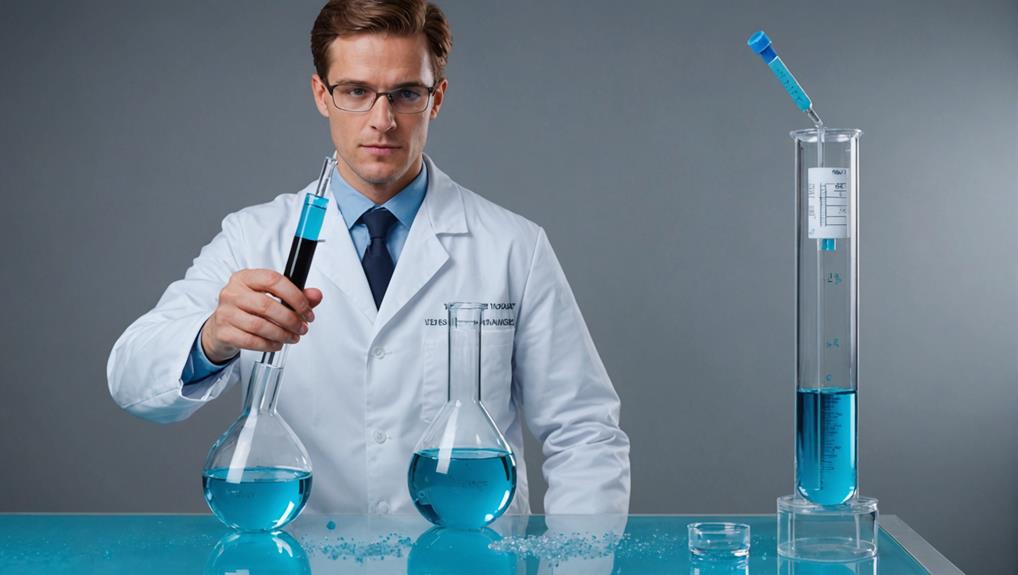When you step into your hot tub, you expect crystal-clear water that's gentle on your skin and eyes, but achieving this ideal state requires a delicate balance of chemicals, including pH levels, alkalinity, calcium hardness, and chlorine levels. If these chemicals are out of sync, it can lead to cloudy, irritating, or even toxic water. By maintaining proper pH levels, alkalinity, calcium hardness, and chlorine levels, you safeguard the efficacy of sanitizers, keeping your hot tub clean and safe. Now, let's take a closer look at the intricacies of water testing and balancing to reveal the secrets of perfectly clear water.
Key Takeaways
- Balanced chemicals prevent cloudy water by maintaining optimal pH, alkalinity, calcium hardness, and chlorine levels.
- Regular water testing identifies imbalances, allowing for corrective action to ensure clear water and prevent equipment damage.
- pH levels between 7.2 and 7.8, alkalinity, and calcium hardness between 150-250 ppm are crucial for achieving perfect water clarity.
- Sanitizers and shock treatments work effectively only when chemical levels are balanced, ensuring the elimination of microorganisms and contaminants.
- Chemical adjustments based on test results maintain optimal water balance, preventing scale buildup, corrosion, and equipment damage.
Chemical Balance and Water Quality
When you test the chemical composition of water, you're likely to find that achieving a delicate balance of chemicals is essential to ensuring good water quality.
This balance is critical in hot tub care, as it directly impacts the overall health and safety of users.
A well-balanced water composition involves maintaining proper pH levels, alkalinity, calcium hardness, and chlorine levels.
If these chemicals are out of sync, it can lead to cloudy, irritating, or even toxic water.
Water testing is vital to identifying imbalances and making adjustments to achieve a balanced water state.
By doing so, you can prevent issues like eye irritation, skin problems, and equipment corrosion.
In addition, a balanced water composition also helps to maintain the efficacy of sanitizers, ensuring that your hot tub remains clean and safe.
Understanding Ph Levels and Alkalinity
You adjust the pH levels in your hot tub by carefully manipulating the concentration of hydrogen ions, which directly affects the water's acidity or basicity.
A pH level that's too high or too low can cause discomfort, eye irritation, and even damage to your hot tub's surfaces.
To achieve a balanced hot tub, you need to maintain a pH level between 7.2 and 7.8.
Alkalinity, which is the measure of your water's ability to resist pH changes, is also vital.
You can adjust alkalinity levels using a Total Alkalinity Increaser.
Calcium Hardness levels, which affect the water's ability to hold minerals, are also important.
You can adjust these levels using a calcium hardness increaser.
When pH levels are too low, you can use a pH increaser to raise them, and when they're too high, you can use a pH decreaser to lower them.
By maintaining ideal pH and alkalinity levels, you'll provide a balanced hot tub that's comfortable and safe to use.
Sanitizer and Shock Treatment Essentials

Now that you've achieved a balanced hot tub with ideal pH and alkalinity levels, it's time to focus on sanitizing the water to eliminate harmful microorganisms and contaminants.
As a key step, you'll need to add a sanitizer, such as chlorine or bromine, to the water. The ideal levels for these sanitizers range from 3 to 5 parts per million (ppm).
Shock treatments are also essential to oxidize contaminants and restore water clarity. You can opt for non-chlorine shock treatments as an alternative to chlorine shock.
Regular shock treatments will help prevent the buildup of chloramines, which cause unpleasant odors and eye irritation. After shocking the hot tub, it's necessary to test the water to confirm sanitizer levels have returned to a safe range.
Follow the manufacturer's instructions when applying shock treatments to avoid imbalanced chemical levels. By maintaining a balanced sanitizer level and performing regular shock treatments, you'll be able to enjoy a healthy and safe hot tub experience.
Remember to test the water regularly to verify a balanced and healthy environment.
Calcium Hardness and Water Clarity
As you maintain your hot tub, you'll want to keep a close eye on calcium hardness levels, which play a critical role in preventing scale buildup and corrosion.
The ideal range of 150-250 ppm is key to achieving perfect water clarity, as it prevents both scaling and aggressive water.
Calcium Hardness Levels
Maintaining calcium hardness levels between 150-250 ppm is necessary in hot tub water to prevent surface damage and guarantee ideal water clarity. As you manage your hot tub's water chemistry, you must understand the importance of calcium hardness levels.
If levels are too low, you risk corrosion of hot tub surfaces and equipment, while high levels can lead to scaling and cloudiness.
Key points to keep in mind:
Calcium hardness levels above 250 ppm can cause the water to become cloudy or form scales on the hot tub surface.
Levels below 150 ppm can lead to etching or corrosion.
Regular testing of calcium hardness levels is necessary to maintain clear water and protect hot tub surfaces.
Calcium hardness increasers, such as calcium chloride, can be added to the water to raise the calcium hardness level and prevent corrosion or scaling.
Proper calcium hardness levels are key for maintaining water balance and preventing issues like pool shock and scale formation.
Ideal Range Importance
Your hot tub's water clarity and surface integrity rely heavily on calcium hardness levels staying within the ideal range of 150-250 ppm. This range is vital for maintaining chemical balance, as it prevents surface damage and guarantees excellent water clarity.
If calcium hardness levels drop below 150 ppm, you may notice corrosion and etching on the hot tub surface. On the other hand, levels above 250 ppm can lead to scaling and cloudiness, reducing sanitizer efficiency and causing skin and eye irritation.
Regular water testing is essential to verify calcium hardness levels stay within the ideal range. You should test your hot tub water weekly to catch any imbalances early.
If your calcium hardness levels are too low, you can add calcium hardness increasers to raise the level, following the manufacturer's instructions for proper dosage and application. By maintaining the ideal range, you'll enjoy clear, balanced hot tub water that's gentle on your skin and eyes.
Scale Buildup Prevention
You can prevent scale buildup in your hot tub by targeting the root causes, including high pH levels, high total alkalinity, and high calcium hardness, which can lead to cloudy water, equipment damage, and skin irritation.
Maintaining balanced water chemistry is vital to preventing scale buildup.
Regularly test your hot tub's calcium hardness levels, aiming for an ideal range of 150-250 ppm.
Use a calcium hardness increaser to raise low levels, and consider an acid wash or draining and refilling the hot tub to remove existing scale buildup.
Monitor and adjust pH levels and total alkalinity to prevent scaling and corrosion.
Perform regular water testing to confirm balanced water chemistry.
Incorporate hot tub maintenance habits, such as cleaning the hot tub regularly, to prevent scale buildup and maintain a clean, safe, and healthy hot tub experience.
Testing and Adjusting Chemical Levels

By regularly testing the water, pool owners can identify chemical imbalances and take corrective action to restore a stable and safe environment.
You should test your hot tub water's chemical levels at least twice a week, and more often if you notice any changes. When testing, pay attention to pH levels, total chlorine, and Free Chlorine.
If your pH levels are too high, you'll need to add a pH decreaser to bring them back down. Conversely, if they're too low, you'll need to add pH increasers.
Regular testing allows you to make these adjustments and maintain proper water balance. When your chemical levels are out of whack, you risk scale buildup, cloudy water, and even equipment damage.
By testing and adjusting your chemical levels regularly, you can maintain your water stays balanced and safe for bathers. Remember, a water-balanced hot tub is a healthy and enjoyable one.
Maintaining Balanced Pool Water Chemistry
Properly maintained pool water chemistry relies on a delicate balance of multiple factors, including pH, total alkalinity, calcium hardness, and sanitizer levels. As you strive to achieve a clear and healthy pool or hot tub water chemistry, it's essential to understand the interplay between these components. You'll need to regularly test and adjust your chemical levels to ensure a stable chemical balance.
Monitor pH levels: Keep them between 7.2 and 7.8 to prevent eye and skin irritation, as well as damage to pool equipment.
Check calcium hardness: Ensure it's within the recommended range to prevent scaling and corrosion.
Maintain sanitizer levels: Keep them at the correct concentration to effectively eliminate bacteria and viruses.
Use test strips or liquid test kits: Regularly test your pool water to identify any imbalances.
Adjust pool chemicals accordingly: Make adjustments based on test results to maintain a stable chemical balance and optimal water care.
Frequently Asked Questions
What Is the Balanced Chemical Reaction for Water?
You form water by combining two hydrogen atoms with one oxygen molecule, creating a chemical bond, resulting in the molecular formula H2O, represented by the balanced chemical equation 2H2 + O2 → 2H2O.
What Order Do You Balance Pool Chemicals?
As you venture into pool maintenance, remember that balancing chemicals is a delicate dance. You'll want to follow a specific order: pH adjustment, alkalinity control, sanitizer levels, calcium hardness, and stabilizer importance, ensuring Chemical Safety and crystal-clear Water Clarity through precise Pool Testing.
What Is the Correct Order for Balancing Chemical Reactions?
When balancing chemical reactions, you'll master the correct order by grasping Stoichiometry Fundamentals, identifying Reaction Types, writing Chemical Equations, and applying Balancing Strategies, Atom Counting, Coefficient Rules, and Reaction Mechanisms, considering Catalyst Roles, Reaction Rates, and Equilibrium States.
What Order Do You Balance Hot Tub Chemicals?
You're like a conductor leading an orchestra, ensuring harmony in your hot tub's chemical levels. First, you adjust the pH, then alkalinity, calcium hardness, sanitizer (chlorine or bromine), and stabilizer, ensuring spa safety, water clarity, and preventing shock treatment.
Conclusion
As you gaze into the crystal-clear waters of your balanced pool, remember that beneath the surface lies a delicate dance of chemicals.
Like a maestro conducting an orchestra, you've harmonized pH levels, alkalinity, sanitizers, and calcium hardness to create a symphony of clarity.
Your testing and adjustments have paid off, and now your pool sparkles like a gem, reflecting the beauty of your hard work.

I’m Max, the founder and chief pool enthusiast behind Pool Pro Tips. As a passionate pool owner and cleaning expert, I created this website to share my knowledge and experience with you, helping you to keep your pool sparkling clean and safe for years to come.

